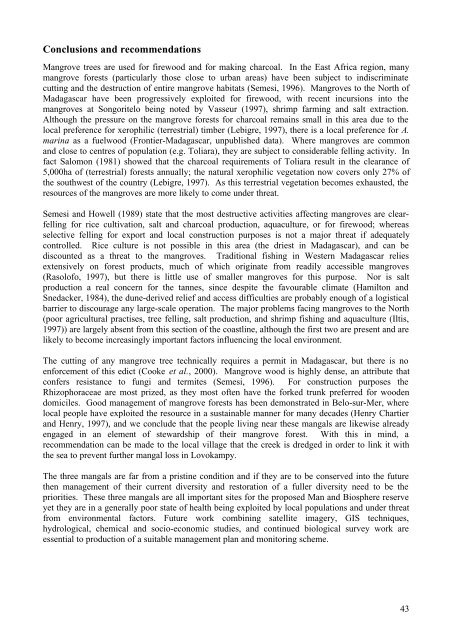Mangrove biodiversity survey south of the Onilahy River - Frontier ...
Mangrove biodiversity survey south of the Onilahy River - Frontier ...
Mangrove biodiversity survey south of the Onilahy River - Frontier ...
Create successful ePaper yourself
Turn your PDF publications into a flip-book with our unique Google optimized e-Paper software.
Conclusions and recommendations<br />
<strong>Mangrove</strong> trees are used for firewood and for making charcoal. In <strong>the</strong> East Africa region, many<br />
mangrove forests (particularly those close to urban areas) have been subject to indiscriminate<br />
cutting and <strong>the</strong> destruction <strong>of</strong> entire mangrove habitats (Semesi, 1996). <strong>Mangrove</strong>s to <strong>the</strong> North <strong>of</strong><br />
Madagascar have been progressively exploited for firewood, with recent incursions into <strong>the</strong><br />
mangroves at Songoritelo being noted by Vasseur (1997), shrimp farming and salt extraction.<br />
Although <strong>the</strong> pressure on <strong>the</strong> mangrove forests for charcoal remains small in this area due to <strong>the</strong><br />
local preference for xerophilic (terrestrial) timber (Lebigre, 1997), <strong>the</strong>re is a local preference for A.<br />
marina as a fuelwood (<strong>Frontier</strong>-Madagascar, unpublished data). Where mangroves are common<br />
and close to centres <strong>of</strong> population (e.g. Toliara), <strong>the</strong>y are subject to considerable felling activity. In<br />
fact Salomon (1981) showed that <strong>the</strong> charcoal requirements <strong>of</strong> Toliara result in <strong>the</strong> clearance <strong>of</strong><br />
5,000ha <strong>of</strong> (terrestrial) forests annually; <strong>the</strong> natural xerophilic vegetation now covers only 27% <strong>of</strong><br />
<strong>the</strong> <strong>south</strong>west <strong>of</strong> <strong>the</strong> country (Lebigre, 1997). As this terrestrial vegetation becomes exhausted, <strong>the</strong><br />
resources <strong>of</strong> <strong>the</strong> mangroves are more likely to come under threat.<br />
Semesi and Howell (1989) state that <strong>the</strong> most destructive activities affecting mangroves are clearfelling<br />
for rice cultivation, salt and charcoal production, aquaculture, or for firewood; whereas<br />
selective felling for export and local construction purposes is not a major threat if adequately<br />
controlled. Rice culture is not possible in this area (<strong>the</strong> driest in Madagascar), and can be<br />
discounted as a threat to <strong>the</strong> mangroves. Traditional fishing in Western Madagascar relies<br />
extensively on forest products, much <strong>of</strong> which originate from readily accessible mangroves<br />
(Rasol<strong>of</strong>o, 1997), but <strong>the</strong>re is little use <strong>of</strong> smaller mangroves for this purpose. Nor is salt<br />
production a real concern for <strong>the</strong> tannes, since despite <strong>the</strong> favourable climate (Hamilton and<br />
Snedacker, 1984), <strong>the</strong> dune-derived relief and access difficulties are probably enough <strong>of</strong> a logistical<br />
barrier to discourage any large-scale operation. The major problems facing mangroves to <strong>the</strong> North<br />
(poor agricultural practises, tree felling, salt production, and shrimp fishing and aquaculture (Iltis,<br />
1997)) are largely absent from this section <strong>of</strong> <strong>the</strong> coastline, although <strong>the</strong> first two are present and are<br />
likely to become increasingly important factors influencing <strong>the</strong> local environment.<br />
The cutting <strong>of</strong> any mangrove tree technically requires a permit in Madagascar, but <strong>the</strong>re is no<br />
enforcement <strong>of</strong> this edict (Cooke et al., 2000). <strong>Mangrove</strong> wood is highly dense, an attribute that<br />
confers resistance to fungi and termites (Semesi, 1996). For construction purposes <strong>the</strong><br />
Rhizophoraceae are most prized, as <strong>the</strong>y most <strong>of</strong>ten have <strong>the</strong> forked trunk preferred for wooden<br />
domiciles. Good management <strong>of</strong> mangrove forests has been demonstrated in Belo-sur-Mer, where<br />
local people have exploited <strong>the</strong> resource in a sustainable manner for many decades (Henry Chartier<br />
and Henry, 1997), and we conclude that <strong>the</strong> people living near <strong>the</strong>se mangals are likewise already<br />
engaged in an element <strong>of</strong> stewardship <strong>of</strong> <strong>the</strong>ir mangrove forest. With this in mind, a<br />
recommendation can be made to <strong>the</strong> local village that <strong>the</strong> creek is dredged in order to link it with<br />
<strong>the</strong> sea to prevent fur<strong>the</strong>r mangal loss in Lovokampy.<br />
The three mangals are far from a pristine condition and if <strong>the</strong>y are to be conserved into <strong>the</strong> future<br />
<strong>the</strong>n management <strong>of</strong> <strong>the</strong>ir current diversity and restoration <strong>of</strong> a fuller diversity need to be <strong>the</strong><br />
priorities. These three mangals are all important sites for <strong>the</strong> proposed Man and Biosphere reserve<br />
yet <strong>the</strong>y are in a generally poor state <strong>of</strong> health being exploited by local populations and under threat<br />
from environmental factors. Future work combining satellite imagery, GIS techniques,<br />
hydrological, chemical and socio-economic studies, and continued biological <strong>survey</strong> work are<br />
essential to production <strong>of</strong> a suitable management plan and monitoring scheme.<br />
43

















